|
Fifty-two years ago in the early evening of November 23, 1963, a gap was filled. BBC TV's drama producer Sydney Newman had been asked to put something in an awkward programming slot, and his solution was to stick a TARDIS in there. In other words, the 30-minute gap was filled by a TV show that offered viewers a window not just into the full breadth of human history, but rather all of Time, throughout the imagined Universe. This unusual and ultimately wildly successful program was Doctor Who.
Doctor Who's debut episode began 80 seconds late. We know this not because fans built their own TARDIS-like time machine and traveled back to the inception date. We know because Doctor Who premiered less than 24 hours after the shocking assassination of President Kennedy. The true reason for the delay is not quite known, although it was believed that TV broadcasters, apparently aware of the public's desire to know what was happening in the States, cut away from that sad coverage slightly late to begin the program.
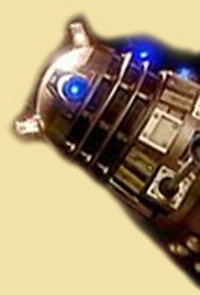 Since the basis of Astrology is all about Time, I decided to launch this "Plog" (e.g., Planetary Blog) by analyzing the advent of Doctor Who, which is also about Time, as well as helping people, confronting problems, meeting monsters, and occasionally saving the World. Astrologers have much in common with The Doctor. We try to help people all the time, confronting their problems in their chart. Some charts can even be quite startling, like seeing a Dalek or a Cyberman army wheel around a corner — as when you run up the birth of a sweet-faced grandmother and spot a grand cross involving Sun/Saturn/Uranus/Pluto. Since the basis of Astrology is all about Time, I decided to launch this "Plog" (e.g., Planetary Blog) by analyzing the advent of Doctor Who, which is also about Time, as well as helping people, confronting problems, meeting monsters, and occasionally saving the World. Astrologers have much in common with The Doctor. We try to help people all the time, confronting their problems in their chart. Some charts can even be quite startling, like seeing a Dalek or a Cyberman army wheel around a corner — as when you run up the birth of a sweet-faced grandmother and spot a grand cross involving Sun/Saturn/Uranus/Pluto.
Maybe astrologers might even save the World someday. But that is a topic for another Plogpost.
Today we will start simple, looking at the event chart for Doctor Who, the birth chart of its creator/producer Sydney Newman, and the natal of the latest (12th) Doctor, Peter Capaldi. We will look at the usual supplemental figures, like what Newman's progressions and transits were up to when he hit the Doctor Who jackpot, and what stars were similarly aligned for Capaldi. But there will be a slight twist in all this.
We now have some new planets out past and around Pluto's neighborhood. Whether you call them Dwarf Planets, Kuiper Belt Objects, planetoids, or a supreme bother, a fair number of these massive bodies are much larger than any asteroid. Astrologers fond of Chiron will be alarmed to know that the dozen mentioned in my recent book, More Plutos, are about 5-7 times larger than that popular chart denizen. In other words, you probably need to know about these new guys, and using Doctor Who, I will inform you about them.
Along with introducing you to the Dwarfs, you will see the expanded capabilities they make possible. For instance, using dwarf planets enables you to progress event charts, both forward and backward. We will see the forward motion with the Doctor Who chart, and track milestones in the "life" of this popular series, marking events that fans of the program felt strongly about.
Time has enough detail in it, if you use Dwarfs, that it appears like a landscape, and this means it has definitive texture, comparable with the shape of other close-by events. Since the Kennedy assassination was, as mentioned, barely a day before Doctor Who's premiere, we should see some similarity in how both event charts secondarily progress, for example.
Special Considerations When Using Dwarfs
One thing I found working with the Kuiper planets, is that best results come from looking at the main, action-producing angles. I'm talking about divisions of the zodiac using small numbers. Dividing by one, of course, produces a conjunction. Two: the opposition. Three: the trine. Four: the square. Those are the majors, and four, really, is just moving farther down the "Two" series, dividing the 360-degree circle a second time. The Two and Three series of angular positions are the major players, indicating when things obviously happen with a person. Divisions of Two produce the conflict and the work, with oppositions, squares, semi-squares, and sesquiquadrates, albeit those last two angles mostly represent annoyances — until it's Pluto annoying your Sun. Divisions of Three give us a break or a boost, with trines and sextiles.
Emphasis on angles is not a new idea. Johannes Kepler, a man respected by astrologers and astronomers alike, championed it more than 400 years ago. He wanted to get rid of all the accretions Astrology had accumulated in the valiant attempt to make it work more reliably — with only five planets and the luminaries, you can imagine that help was indeed needed. Kepler objected not just to Arabic Parts, but even wanted to dump the Zodiac signs as unworthy of consideration. I won't go that far, but stick with me and you might see the wisdom and elegance in this approach.
If you really think about it, would you expect to win a Nobel and only see a semi-sextile to explain it, whether in transit or progression? Would debuting a brilliant piano concerto be shown only by a quincunx? If you say, "Yes, I have seen only that aspect explain a great success," I would reply, "You didn't see a conjunction, trine, or sextile because you needed Dwarf Planets."
So in order to emphasize the major angles, to really hone in on them exclusively, I shall present chart information in a diagram. I will also provide links to some full wheels, but when you look at wheels with all the Dwarf Planets and large Asteroids included, you may appreciate how my diagrams make plain what is of most importance in a key moment or a person's natal.
Now to ask, what can Astrology tell us when we program our own TARDIS, the astrology chart software we all use, to take us back to late Autumn of 1963?
Doctor Who's Inception
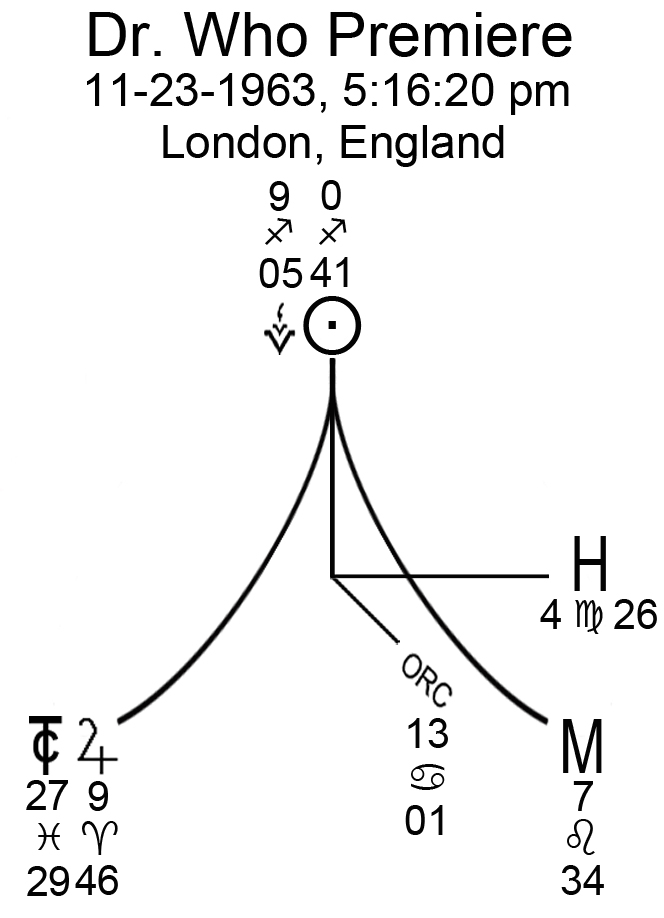 Here is the condition of the Sun on that now famous date. As you can see at right, this is not a busy chart of major angular activity. The Sun has just separated from a sesq. to Orcus and trine to 2002 TC302, and applies to square Haumea and trine Makemake. I shall interpret these contacts in a moment, but for now just note how there are no major angles to anything familiar: the conjunction to asteroid Vesta is wide, as is the trine to Jupiter. If you resist wide aspects, this Sun has nothing for you if you don't credit the mid-sized objects in our System.
Here is the condition of the Sun on that now famous date. As you can see at right, this is not a busy chart of major angular activity. The Sun has just separated from a sesq. to Orcus and trine to 2002 TC302, and applies to square Haumea and trine Makemake. I shall interpret these contacts in a moment, but for now just note how there are no major angles to anything familiar: the conjunction to asteroid Vesta is wide, as is the trine to Jupiter. If you resist wide aspects, this Sun has nothing for you if you don't credit the mid-sized objects in our System.
Doctor Who Premiere Wheel
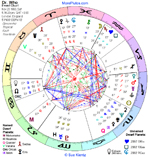
Click for full view
This is because the advent of Doctor Who is a time that brought something totally new, odd, different, and non-mainstream into consciousness. It's not a comfortable time, and Doctor Who was not ultimately a feel-good proposition. Children found the program terrifying as well as stimulating and exciting. Even the theme song disturbed people, its electronic tones unfamiliar and unsettling. Dwarf Planets well represent such a time, and that's why they are here in force.
Except for TC302 and asteroid Vesta, the Dwarfs appearing here are thoroughly explained in my book and in several published articles found on my website (see home page), so I'm not going to defend my interpretations here at length (I do promise a thorough treatment of TC302 is one of these plogposts, soon). So just briefly to get you oriented, here is what is happening in this figure:
Sun sesq. Orcus, separating: There is a need for order, for relying on the tried and true, the accepted process, to comfort oneself that All is Well. Certainly people throughout the world were yearning for that safety in the wake of America's president being shot. Not just that, but only a year earlier, nuclear war seemed only narrowly avoided between Russia and the U.S. after they squared off over the Cuban Missile Crisis. Atomic weapons were still a great fear at this time. How did anyone cope?
One strategy is to look to a set procedure kicking in, to make one feel that the world won't collapse around you. Someone needs to step forward and take charge, have a plan, restore order and confidence. In the U.S., Vice President Johnson had just been sworn in, and the procedures of presidential succession were at work.
At such a time, then, what could be more comforting than the appearance of a Doctor?
Sun sq. Haumea, applying: When you get right down to it, every episode of Doctor Who isn't just a joy ride through Time. He fixes something; he kills in order to save himself or his companion(s). He saves people, restores them to life. The Doctor is Haumea personified.
Haumea is the fourth-largest Kuiper Object, and conjoined with Pluto, brought us the Hiroshima and Nagasaki blasts that ended World War II in Asia. Death brought a chance for peaceful Life. A similar conjunction of Haumea/Pluto/Mars brought British, American, and French soldiers to Normandy's beaches in that war's European Theater. Pluto takes control, but Haumea kills and transforms. Pluto and Haumea are an interesting pair, and they do pair up a lot throughout history. In fact, the two have made a series of five separate conjunctions since Luther nailed the 95 theses to his church door to kick off the Reformation. Luther took control, and his audacity shook the foundations of the Catholic Church, a Pluto-Haumea one-two punch.
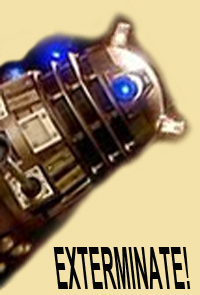 Real-life doctors deal daily with life and death, and the fictional Doctor is no different. He has come to save the World, whether that's our familiar Earth, an unfamiliar distant world in another galaxy, or even the Universe itself. How very fitting that this great traveler isn't outfitted with just a magically speedy Spaceship, but rather a Time machine, the modest-looking TARDIS. If you can change Time, you can change Everything. It's the ultimate Undo button. Real-life doctors deal daily with life and death, and the fictional Doctor is no different. He has come to save the World, whether that's our familiar Earth, an unfamiliar distant world in another galaxy, or even the Universe itself. How very fitting that this great traveler isn't outfitted with just a magically speedy Spaceship, but rather a Time machine, the modest-looking TARDIS. If you can change Time, you can change Everything. It's the ultimate Undo button.
Sun trine Makemake, applying: If Doctor Who was only about life and death issues, certainly that would be a tiresome and exhausting half-hour to repeatedly endure each week. Makemake brings pizzazz, fun, a scintillating electric jolt from the eccentric personality of the Doctor. He's a bit mad, as he often admits, but you would have to be to live such an itinerant life, zooming around the Universe not just spatially but through its fourth dimension as well.
The unusual science of Doctor Who's world is Makemake. What Quantum Physics is to Physics, is what Makemake is to Uranus. Sun trine Makemake gave us Ben Franklin, who dreamed up the lightning rod. Sun conjunct Makemake produced Salvador Dali and his shocking art. The British children who hid behind the couch when monsters appeared on the show, may have been afraid of the Haumea-danger of being EXTERMINATED, but the excited delight in being scared by a TV show was Makemake.
Sun trine 2002 TC302, separating: This dwarf planet candidate might be on the small side, and it might not. Astronomers thought it was as big as 1000km in diameter, but after it occulted a star, they revised their estimate down to 584km, give or take a hundred km. But it could be bigger, depending on its orientation at occultation, as some of these distant planets are irregular in shape (for example, Haumea is more football-shaped than sphere). It may have hid its true size, and with its very close resonance with Neptune, orbiting twice around the Sun each time Neptune orbits five times, TC302 may be exceptionally talented in hiding and choosing what to reveal.
Perhaps a key ability of the Doctor is to hide himself and all his great technology, in the seemingly small TARDIS. His Spacetime-ship looks small, but it's really huge inside. That's TC to a T. Archaeologist Howard Carter had Mercury opp. TC, and when his p. Mercury squared p. TC, a little stairway in the dusty Egyptian desert unexpectedly revealed to him the fabulous tomb of King Tutankhamun and its precious treasure. Teamster boss Jimmy Hoffa had Sun/Mercury/TC conjunct at birth, and we're still looking for him. TC can be a great help to astrologers, as it can tip you off that there's something not quite kosher in a person or event. New England Patriot QB Tom Brady? Remember the deflated footballs? Brady, who said he knew nothing about who did it, is Sun trine TC. Say no more!
Milestones: When the Heavens Look Like You
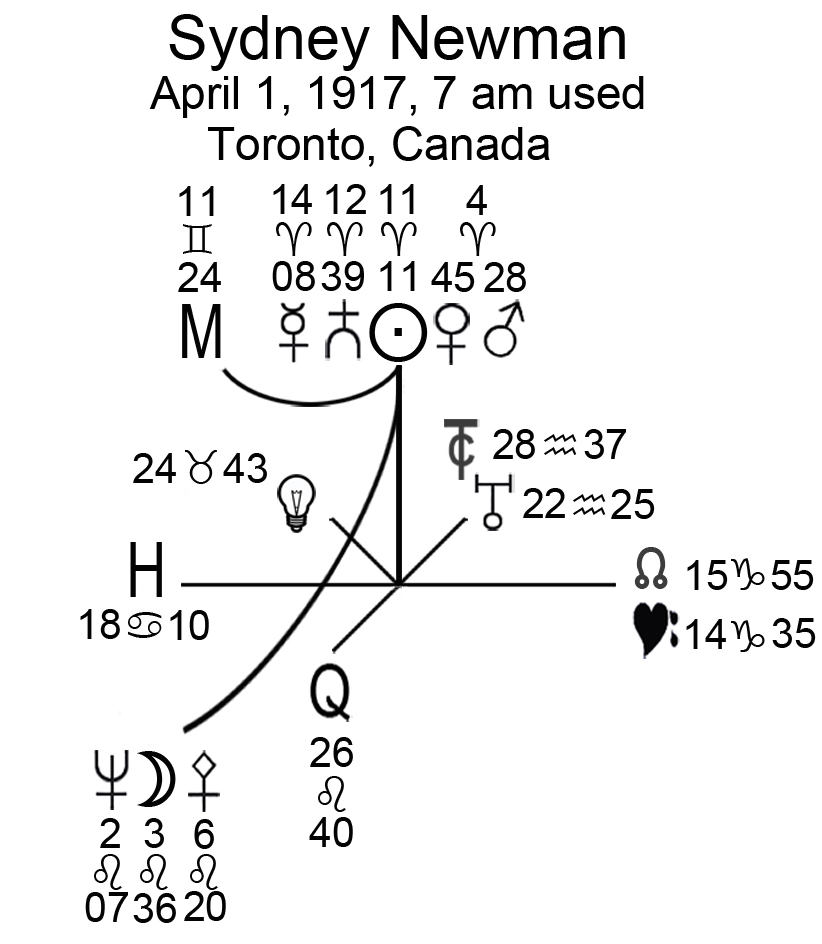 So this sci-fi program's debut is unarguably a great moment in Time, an event appreciated by legions of Doctor Who fans, but there is a special connection to be found if you look at the birth chart of the person who thought of putting Doctor Who in that troubling gap in BBC TV's schedule. Sydney Newman also came up with the idea of the TARDIS and the particular character of the eponymous Doctor. He basically created the most-loved elements of the show. Does the creation resemble the creator? Let's see, via diagrams, if there is a resemblance:
So this sci-fi program's debut is unarguably a great moment in Time, an event appreciated by legions of Doctor Who fans, but there is a special connection to be found if you look at the birth chart of the person who thought of putting Doctor Who in that troubling gap in BBC TV's schedule. Sydney Newman also came up with the idea of the TARDIS and the particular character of the eponymous Doctor. He basically created the most-loved elements of the show. Does the creation resemble the creator? Let's see, via diagrams, if there is a resemblance:
Sydney Newman natal wheel
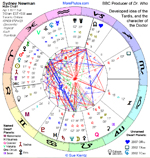
Click for full view
Newman had a good dose of Haumea, Makemake, and TC302 traits apparent in his natal, and not just contacting his Sun — note that his Mercury, too, is sextile M, square H, and semi-square TC. Another interesting repeat of planetary "theme" — not demonstrated fully here but you can see it by checking out the wheels — is both Newman and the premiere have Venus conj. Mars. His greatest success resembled him like a child resembles a father.
Including the Dwarfs makes this "family resemblance" very obvious, as you see it much more frequently. I first noticed it looking at Meredith Willson, the 20th Century composer who gave us The Music Man. Willson was Sun semi-square Sedna, another powerful massive Dwarf best described as representing tenacity. Willson was tenacious all right; he worked on the musical's book for 10 years and went through 40 drafts, but once he perfected it, his "baby" was a smash success. And each time The Music Man debuted, whether on stage or on film, the Sun was trine Sedna. When Willson died, the Sedna theme resounded with even his same birth angle, Sun semi-square Sedna.
It's as if birth sets off a repeating pattern, and the planetary markers or themes present at birth, repeat at your important milestones and again at death, like concert music repeats the opening key and signature melody at transitions in the music and then at the final crescendo. Astrology in this way reveals that life mimics the structure of music.
What could that be telling us? That our bodies are instruments with which we create a song (or disturbing noise, if we live badly)? Perhaps it means we are meant to join together, like an orchestra, and create some indescribable thing of Beauty.
People Need to Fit
How about a person who perhaps isn't a progenitor of a project, but who "fits" into its scheme, who seems ideal for a starring role? To continue the example of Willson and Music Man for a moment, that man was actor Robert Preston. He was the definitive Harold Hill and played the title role on Broadway and in the Hollywood film. And yes, Robert Preston was Sun sextile Sedna, and shared a few more natal themes with Willson. But this makes sense, as those debuts on Broadway and at the movies were his milestones, too.
This brings me to the many Doctors of Doctor Who. Does each have the same planetary themes as Newman and the debut Doctor Who chart?
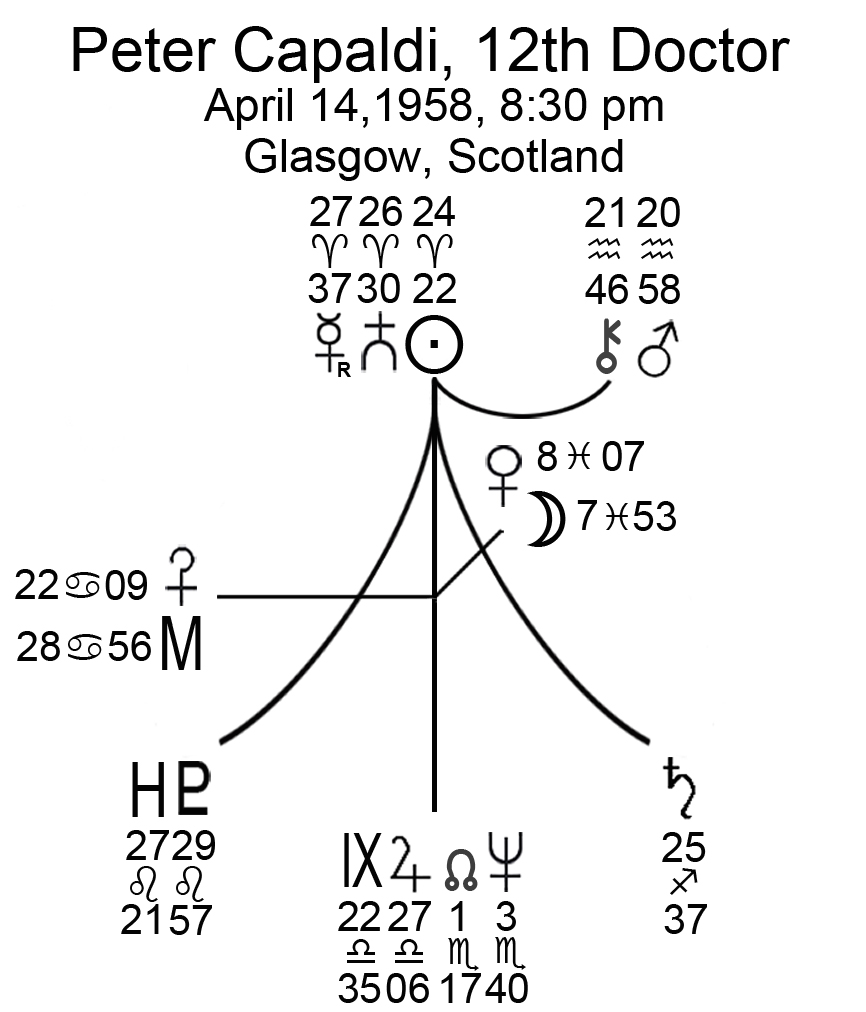 Looking over this table, Haumea and Orcus must be indispensable traits for a prospective, convincing Doctor. The Doctor needs that create/destroy aura of Haumea, and be able to organize, a la Orcus. His plans may often be spur of the moment, but the Doctor has the gift of arranging a welcome outcome (certainly thanks to the script, but this still seems a part of the integral character of the Doctor, as agreed on by all, on screen and behind the scenes).
Looking over this table, Haumea and Orcus must be indispensable traits for a prospective, convincing Doctor. The Doctor needs that create/destroy aura of Haumea, and be able to organize, a la Orcus. His plans may often be spur of the moment, but the Doctor has the gift of arranging a welcome outcome (certainly thanks to the script, but this still seems a part of the integral character of the Doctor, as agreed on by all, on screen and behind the scenes).
Peter Capaldi natal wheel
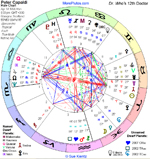
Click for full view
Peter Capaldi, the 12th and current Doctor, has a particularly apt chart, with nearly all the Doctor-event solar characteristics except for TC302. Perhaps the opposition to Neptune is a stronger statement and more than makes up for his lack of secretive TC.
Transits and Progression
Sydney Newman
Transits
Show
creator Newman didn't just reach the moment of premiering Dr. Who on a lucky day. This moment was a culmination of long processes.
Eris was in late Pisces when Newman was born. Eris denotes issues with Others, aliens or just people you don't know or understand. Eris is a natural pair with Pluto. As Pluto tries to control others, Eris wants to connect with others (good aspects) or rejects them out of hand (if placement is difficult).
Newman's first major contact with Eris was when it transited his Venus/Mars, in the 1930s. He tried to make it in Hollywood, and was engaged by Disney as he was a talented artist, but he could not get a work permit. He had to return to Canada, as he was unable to shake his "alien" status, a situation that caused him problems (Mars) with money (Venus). His talents were prodigious, however, so eventually he moved to Britain to work in television, and soon landed at BBC, just as Eris was approaching his natal Sun. And what is he interested in producing? A show centered on an alien, a Time Lord called the Doctor who travels the Universe. Eris triumphant! It was just icing on the cake that at the same time Eris was conjunct his natal Sun, that transiting Jupiter was there too.
As Doctor Who built its following in ensuing years, transiting Makemake trined his natal Sun, then natal Mercury. The quirky Doctor would entertain and enthrall a generation, as alien Eris continued to touch Newman's most personal planets.
Progressions
I've provided the full Sun diagram for Newman, progressed to the Doctor Who premiere, but am just going to point out a few relevant parts (as this isn't a thorough life analysis).
Just as Eris is slowly transiting Newman's Sun, in progression his p. Sun is just beginning a 4-5 year sextile p. Eris, again as the aliens featured on Doctor Who gain the show a following. His production appears sound and lasting, with p. Sun sextile p. Saturn.
Comparable to transiting Makemake forming trines to n. Sun/Mercury, progression shows his p. Mercury retrograding to conjunct Jupiter and square Uranus. An apt figure, as Makemake could be considered basically equal to a Jupiter/Uranus combination.
Note how with Dwarf Planets added, you sense that you can see Newman's major milestone of founding this popular sci-fi TV show, whether you looked at his Transits or his Secondary Progressions. When milestones appear in both of these patterns, it's more obvious that the patterns are more fully detailed and, in fact, related. The "slower" developing pattern of Secondary Progression, that flowering of the natal chart in the first 90 days or so, is a fractal or miniature, self-similar pattern to the Transiting, real-time pattern of approximately 90 years. If astrological cycles are fractals, astrology might have a viable scientific basis to be better understood and more widely appreciated.
Peter Capaldi
Transits
Just as Eris approached Newman's Sun/Mercury as he brought forth Doctor Who, Eris now moved to conjunct Capaldi's Sun/Sedna/Mercury stellium. Here's another case where appearing Alien is a good thing, as Capaldi is a big fan of the Doctor Who series and hoped someday to be its Doctor. See that Haumea is also moving opposite his n. Sun, giving him that gravitas of dreadful life-death power over others. The trines from Edison, a marker of good starts and bright ideas, and Ixion (daring, iconoclastic) and Quaoar (playful, gambling, experimental) bode well for this time of his life, supporting him and denoting he perhaps has the energy and sparkle to portray the Doctor, despite the fact he is older than any Doctor since the 1970s.
Progressions
Secondary progression to his reveal as The Doctor tells us that Capaldi does face opposition due to his age, with his p. Sun approaching p. Saturn, exact in a few years. But here too, we see very fortunate supporting trines from Quaoar, Ixion, and Jupiter on one side, Chiron on the other. His progressed Sun suggests he will enjoy his Doctorship perhaps as long as through 2017; if he leaves earlier, the trines to the Jupiter stellium would indicate some other great success awaits him on his personal path through Time.
The Landscape of Time in November 1963
It is not uncommon to see the passing of a main player of some enterprise, in the
secondary progressed chart of the enterprise's founding, and have that involve Haumea.
That particular figure can be seen using the U.S. chart of the Declaration of Independence, which progresses to Sun trine Haumea when a significant player in the country's
founding passed from the Earth. I'm talking about
George Washington, who died on December 14, 1799. If you progress the U.S. mundane chart (2:17 a.m. used), you have:
p. Sun (5 Leo 06) trine p. H (5 Sagit 33)
You don't get more instrumental or central than Washington, or as beloved, being our first president and the general who led the colonies to victory in the Revolutionary War.
So it is no surprise that this also happened with the Doctor Who debut chart, which when progressed to p. Sun trine p. Haumea, is when
producer Sydney Newman died (see below left):
Recall that Doctor Who "began" just a day after JFK's Assassination. That chart is such a milestone for the American people, for the Kennedy family, and Kennedy's legacies like the Space Program. This chart is also progressible like the Doctor Who chart. What compares, however, with Sydney Newman's death, in the JFK Assassination chart progression?
The death of JFK's son is the comparable chart. Whereas the Doctor Who chart shows that some beloved (Sun trine H) has died, in this case the originator of the show, progressing the JFK milestone brings us to the death of a child (trine H). The news in either case is disturbing with Mercury sesq. H.
Now if you recall the original charts, you might ask, what happened just a few years after the event, when progressed Sun and Haumea perfected the square?
In the JFK death chart, the progression of Sun sq. H becomes close to exactitude when Robert F. Kennedy is shot on June 6, 1968:
p. Sun (4 Sagit 18) sq. p. H (4 Virgo 37)
To see that this milestone shakes the status quo just as Kennedy's assassination does, know that p. Moon (12 Aries 34) squares p. Orcus (12 Cancer 58).
In the Doctor Who chart, a dramatic change, a "death" of sorts, takes place the first time the show changes the actor playing the Doctor. Patrick Troughton debuts in the role on October 29, 1966 at:
p. Sun (3 Sagit 39) sq. p. H (4 Virgo 27)
Again, the Moon gives the detail that tells us this transition was a success, and theatrical instead of disturbing, with p. Moon (3 Aries 05) trines p. Sun (3 Sagit 39). This progressed Moon recently was semi-square p. Saturn (17 Aquarius 31), perhaps indicating the anxiety of the show's handlers, since no one knew if audiences would accept a new and quite different actor playing the popular Doctor until they actually initiated the change.
Let's now see how, later down the line, progressed Sun sesquiquadrate Haumea corresponded with another disturbing event.
In the path of the Doctor Who program's progression, at p. Sun (18 Capricorn 53) sesq. p. H (4 Virgo 13) the fourth Doctor Tom Baker's on-screen companion, Elisabeth Sladen (who played "Sarah Jane"), died of cancer on April 19, 2011, emotionally affecting the Doctor Who community, causing national and even international sadness, with many taking note of her passing and honoring her with tributes.
That same figure appeared in the Kennedy Assassination progressed timeline when the Kennedy family suffered yet another tragic death, the suicide of Robert Kennedy Jr.'s estranged wife Mary Richardson Kennedy on May 16, 2012. See how close the progressed positions are, different only in that at Sladen's passing, the p. Sun is sextile p. Neptune, as the beloved loss is someone with a career in film. In Kennedy's case, p. Sun is sextile p. Pallas. Mary Kennedy was known for her concern for the environment and her advocacy of "green design," as well as for her battles with alcohol and DWI charges.
Again to reiterate, only with Dwarf Planets added do you have the level of detail to see that Event Charts can progress to milestones related to the event. Apparently the Event itself creates a nexus for people who are affected by what happens, and therefore a Community is created. A body of people thus bound together act as a unified entity, and react to further developing events that come after, reacting as if One Person.
Stay Tuned for more about Time and Dwarf Planets. There is much more to explain and reveal.
Birth Data Used
Baker, Colin. June 8, 1943, 7 a.m. used, London, England, wikipedia.org
Baker, Tom. January 20, 1934, 5:40 p.m., Liverpool, England, astro.com
Brady, Tom. August 3, 1977, 11:48 a.m., San Mateo, CA, astro.com
Carter, Howard. May 9, 1874, 4:16 a.m. rect., London, England, biography.com
Capaldi, Peter. April 14, 1958, 8:30 p.m., Glasgow, Scotland, astro.com
Davison, Peter. April 13, 1951, 7 a.m. used, London, England, wikipedia.org
Eccleston, Christopher. February 16, 1964, 7 a.m., Salford, England, wikipedia.org
Hartwell, William. January 8, 1908, 7 a.m. used, London, England, wikipedia.org
Hoffa, Jimmy. February 14, 1913, 6:52 a.m., Brazil, IN, astro.com
McCoy, Sylvester. August 20, 1943, 5 a.m., Dunoon, Scotland, astro.com
McGann, Paul. November 14, 1959, 7 a.m. used, Lancashire, England, wikipedia.org
Music Man (Broadway). December 19, 1957, ibdb.com
Music Man (film). June 19, 1962, imdb.com
Newman, Sydney. April 1, 1917, 7 a.m. used, Toronto, Canada, wikipedia.org
Pertwee, Jon. July 7, 1919, 7 a.m. used, London, England, wikipedia.org
Preston, Robert. June 6, 1918, 12:00 p.m., Newton, MA, astro.com
Smith, Matt. October 28, 1982, 7 a.m. used, Northampton, England, wikipedia.org
Tennant, David. April 18, 1971, 7 a.m. used, Bathgate, Scotland
Troughton, Patrick George. March 25, 1920, 7 a.m. used, Mill Hill, England, wikipedia.org
Willson, Meredith. May 18, 1902, 7 a.m. used, Mason City, IA, masterworksbroadway.com
Return to the Plog
|
